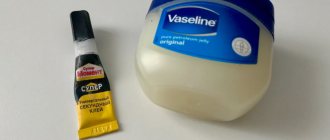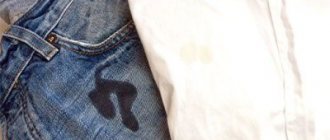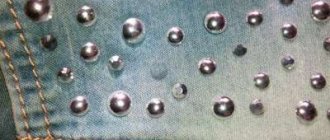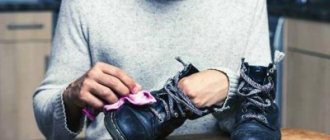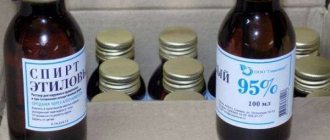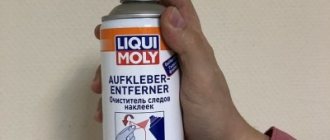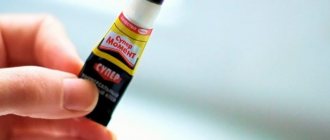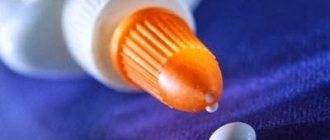Working with glue requires extreme care and precision. One careless move, and there’s a glue stain on your favorite jeans.
Many people consider such pollution to be irremovable. However, it is not. There are a sufficient number of ways to remove glue from jeans.
In this article we will tell you how and how to remove glue from jeans at home using folk remedies and household chemicals.
How to remove different types of glue from fabric
Glue Titan
The first method is mechanical:
- Spread the stained item on a flat, hard surface.
- Place gauze on top.
- Hit the product with a hammer.
- Remove what remains with a nail file.
If this does not help, use nail polish remover (you can use solvent 646) or dimexide as described above.
Moment
If the fabric is synthetic, simply wipe it with acetone or refined gasoline (available at hardware stores). Products made from natural fabrics are cleaned in this way:
- In 1 tbsp. add 2 tsp water. citric acid and stir well.
- Wipe the stain with the solution using a soft cloth.
- Wash clothes as usual.
Super glue
Superglue stains are one of the most common stains, so there are many ways to remove them. How to remove fresh and dried stains, see here.
PVA
These stains are removed by regular washing, and you must first soak the item in a warm powder solution. If the material is natural and the stain is old, then wipe it with alcohol and wash it after half an hour.
To remove PVA from a suede product, boil water and hold the contaminated area over steam for three minutes, and then remove the softened stain with a clean cloth. PVA stained silk? Keep it in the freezer, after which the stain can be easily crumbled and removed.
Woody
Fresh wood glue is removed from clothing by soaking and washing. If the substance has already dried, then after soaking it should be scraped off with a knife, then treat the contaminated area with a clothes brush and wash.
Clerical
Since this composition does not penetrate deeply into the fabric, it will be easy to get rid of the stain. Soak the material for half an hour in cold water, then rub with laundry soap and wash.
Casein glue
Ammonia or glycerin can easily cope with it. Apply the product to a cotton swab and hold it on the stained area until the fabric is saturated. If the material is dense, scrub it with a brush. At the end, the product should be washed as usual.
If casein glue gets on your jeans, rub the fabric with gasoline, then wash the product by hand to prevent the washing machine from smelling of a pungent odor.
Textile
The glue used for decoupage on fabric cannot be removed by simple washing. White spirit or another solvent is used for this purpose. You can try refined gasoline. All these substances should first be tested on an inconspicuous area of clothing.
Before starting work, be sure to wear gloves and a respirator.
Silicone
If the silicone glue has not yet penetrated the fabric, then removing it is as easy as shelling pears. Gently stretch the stained area of the material, as a result of which the glue forms a film that will need to be removed from the surface.
Another way is to lubricate the stain with vegetable oil: after 2 minutes the silicone will dissolve, and all that remains is to wash the item.
When removing silicone adhesive in any way, you should wear gloves, a respirator and safety glasses.
If the glue has become embedded in the fabric, wet the stain with vinegar, and after half an hour, remove the stain with a soft cloth.
Mucilage
These are paper bonding agents that are made from resin, rubber or starch. To remove traces of rubber glue, wipe the problem area with gasoline, sprinkle starch on it and wait three to four hours. After this, wash the item with laundry detergent or gel.
To remove other types of vegetable glue, do the following:
- Mix 20 g of soda ash, 2 tbsp. spoons of ethyl alcohol and 5 tbsp. l. filtered water.
- Soak a cotton swab in the mixture and apply to the contaminated area.
- Wash the item as usual.
Universal recipes
Remember that the type of material from which Moment glue needs to be removed plays an important role. Often the type of fabric determines the choice of the necessary product.
There are a number of universal recipes for each fiber.
- You can remove glue from suede fabrics using gasoline. To do this, you need to wet a clean cloth in the composition and rub the stained area with it.
- If a Moment stain gets on artificial leather, a mechanical cleaning agent such as a nail file is often used. By making circular movements over the dried liquid, the item is carefully removed from the stain.
- For white things, the universal recipe is whiteness. Since this mixture contains chlorine, it will effectively cope with pollution. It must be applied to the stained area and rubbed with another cloth.
- Natural fabrics such as silk and wool can be cleaned using gasoline. A small piece of soft cloth will need to be soaked in gasoline, placed on the stain for about a quarter of an hour so that the stain is well soaked, and washed with laundry soap or washing powder.
- There is a separate recipe for removing old stains from persistent glue from clothes. To do this, use two components: washing powder and baking soda. A composition prepared from two tablespoons of powder dissolved in three liters of water and mixed with three tablespoons of soda is used to soak the item for three or four hours. If the fabric is delicate, it can be scrubbed using a stiff brush. After this, as in all other cases, you need to rinse things several times in clean water.
What not to do
The sooner you start dealing with a glue stain on fabric, the more likely it is that it will disappear without a trace. But there are actions that are not recommended. When cleaning fabrics from glue, you must not:
- use any products without agreement with the rules for caring for a specific type of fabric;
- forget that before using any product, it must be tested in an inconspicuous area;
- exceed the operating time of the cleaning composition, otherwise the material of the product may be damaged.
It is not difficult to remove stains from one or another type of glue from different fabrics if you choose the right method for cleaning the materials. There is a whole range of special and folk remedies for eliminating pollution of this origin. By selecting them according to the type of fabric, type of glue and degree of freshness of the stain, you will cope with the task.
Anticlean
Now almost all manufacturers of adhesive compositions are developing specialized products for their removal. These are so-called anti-adhesives. Their use can be justified at any stage of glue drying. Even if the jeans have been stained for a long time, anti-glue will cope with this task effectively.
For treatment, the product is applied to the problem parts of the jeans and left for some time. The duration of action depends on the type of cleanser. Information can be read on the packaging. After the anti-glue has cured, it should be scraped off from the material. After this, the jeans are washed.
The anti-glue should be chosen from the same company as the adhesive solution.
How to remove traces of thermal stickers or labels at home?
You can deal with the sticky mark using different methods. The item can simply be washed, doused with boiling water, or frozen.
If the fabric does not tolerate contact with high and low temperatures, improvised means in the form of alcohol, vegetable oil or acetone come to the rescue.
Wash
The easiest way to get rid of sticky residue is to wash it. To begin with, you can resort to classic washing, using regular powder. If there is no effect, they “arm themselves” with laundry soap. It contains fats that effectively dissolve the adhesive base.
Mode of application:
- The contaminated area is moistened and thoroughly soaped.
- Leave the item to act for an hour.
- Clean the area with a toothbrush.
- Rinse the item in water.
Instead of soap, you can use liquid dishwashing detergent.
Scotch
The tape has a sticky base, which, like an eraser, can be used to remove the sticky mark from the label. Proceed as follows:
- lay out the fabric on a flat surface;
- a strip of tape is applied to the stain;
- iron it with your hand for a tight connection;
- tear off the tape with a sharp movement, holding the fabric;
- repeat the procedure until the item is completely clean.
If visible glue particles remain on the fabric, remove them using a cotton pad moistened with vodka or cologne.
Boiling water
You can remove the glue from the label using boiling water. Before you begin the procedure, you need to study the information on the label.
If the manufacturer allows washing in hot water, proceed as follows:
- Heat water in a kettle.
- Place the item in a basin and pour boiling water on it. Under its influence, the glue should come off.
- When the water has cooled slightly, the item is inspected, the remaining glue is removed with a brush and laundry soap.
This method is not suitable for cleaning brightly colored or delicate fabrics.
Hairdryer
If the fabric is not afraid of contact with high temperatures, then a hairdryer comes to the rescue in the fight against sticky marks. With its help you can remove even the most difficult adhesive stains.
Procedure:
- place the item on a flat surface;
- turn on the hairdryer;
- bring it to the stain as close as possible, but not too close;
- Using the back of a knife, remove the softened glue from the clothing.
If after the procedure it was not possible to completely remove the glue, use alcohol. It is applied to the hard side of the sponge, which is used to process a section of fabric in the direction from the edge to the center.
Freezer
The sticky layer can be easily removed if frozen. This method does not require much effort.
Procedure:
- Place the item in a bag.
- Place it in the freezer for an hour.
- Remove frozen adhesive using the back of a knife, a play-doh stack, or a putty knife.
It is not recommended to use an object that is too sharp, such as a blade, so as not to damage the fabric.
The adhesive base does not withstand low temperatures, so removing it will not be difficult. To consolidate the effect, clothes are washed.
Vegetable oil
Vegetable oil dissolves the adhesive base perfectly, but it itself can leave greasy stains on the fabric. To avoid having to throw away the item after cleaning, you need to follow the instructions:
- vegetable oil is applied to a cotton pad and the sticky mark is cleaned with it - you need to act precisely, without touching the clean fabric;
- absorb remaining oil with a paper napkin;
- Apply dishwashing liquid to the stain and leave for 30 minutes;
- wash the fabric in warm water with powder or soap.
You need to saturate the cotton pad with a minimum amount of oil so that it does not drip from it.
Alcohol
Alcohol and alcohol-based substances, such as vodka or perfume, dissolve glue well.
Mode of application:
- Apply alcohol-containing liquid to gauze folded in several layers.
- Wipe the stain with it until it is completely removed.
- Rinse the item in warm water.
If the glue layer is thick, apply alcohol directly to the stain and leave for 15 minutes. After this, they begin cleaning.
Acetone
Acetone has not only a pungent odor, but also a caustic composition, so it must be used carefully, in a well-ventilated area. If the fabric is colored, then it is better to use nail polish remover to remove stains.
The concentration of acetone in it is not too high, but it is enough to remove sticky marks.
If the fabric is colored, then it is better to use nail polish remover to remove stains. The concentration of acetone in it is not too high, but it is enough to remove sticky marks.
Mode of application:
- apply liquid to a cotton pad;
- use it to remove glue from the fabric;
- if the stain is difficult to clean, leave the disc on it as a compress for 5-10 minutes;
- After processing, the item is washed.
You can work with acetone only with gloves. In order not to spoil the item, the product is tested on an inconspicuous area.
Instructions for cleaning clothes
This instruction contains several ways to remove glue from clothes. The principle of operation differs depending on the type of adhesive composition. Any deviation from the listed actions can aggravate the situation and irreversibly damage the fabric.
Polyvinyl acetate (PVA)
Polyvinyl acetate glue, in comparison with “Moment”, “Titanium” or “Superglue”, is cleaned with minimal effort. When it gets on the fabric, it leaves light stains. It can be easily removed, no matter how much time has passed since the first contact. The procedure for removing uncured PVA glue is as follows:
Cleaning of hardened PVA glue is carried out using the following steps:
Important! Alcohol-based compounds should not be used on dark jeans. It will no longer be possible to restore burnt paint. The method can be used on most fabrics.
Removing hardened PVA glue from delicate fabrics (viscose, organza, chiffon):
Liquid glass
This concept means an aqueous alkaline solution of glassy silicates or silicate glue. According to its chemical characteristics, it is classified as an aggressive substance, the stains of which are much more difficult to remove from clothing than traces of PVA glue. The molecules of the composition are firmly “eaten” into the structure of the fabric so that in many cases it is no longer possible to separate them. A positive result is only possible on dense tissues. This is done as follows:
Healthy! To enhance the soaking effect, add 50 g of baking soda to the solution. After 3 hours of exposure, the stain is removed using similar actions.
Removing Moment Stains
Cleaning clothes from traces left by Moment glue is only possible using the special SuperMoment Anti-Glue composition, which quickly deals with most existing stains. The operating principle is as follows:
Healthy! Super Moment Anti-Glue can be used to remove stains from skin. To do this, apply the composition for 5-10 minutes, then thoroughly wash the area with soap and water.
Cleaning Superglue stains
The peculiarity of such stains lies in the wide variety of adhesive compositions. They can be built on wood, rubber or other base. Therefore, next we will consider several different ways to combat them:
Removing stains from liquid nails
Cleaning clothes from stains left by adhesives belonging to the Liquid Nails group is only possible if they were left recently. There are no effective means for removing dried traces of glue yet.
Uncured “Liquid Nails” stains are removed with solvent, acetone, white spirit or other liquids related to similar types of petroleum products. The procedure is to perform the following actions:
Removing stains left by wallpaper paste
In terms of its structure, wallpaper glue belongs to polyvinyl acetate (PVA) compounds. Thus, you can remove it from clothes in the same way as regular office glue. For this you will need:
Uncured glue should come off. Cleaning the dried material is carried out in another way:
Silicone compounds, sealants
It is advisable to clean clothes from silicone immediately after contamination. Removing stains at this stage is much easier than removing already hardened ones. The idea is that a fresh trace can be washed off with running warm water, but you will have to work hard to remove the old one. In addition, only dense fabrics such as jeans and drape can be subjected to such cleaning. When cleaning thin ones, there is a high probability of damaging the structure of the material. The procedure is as follows:
If the stains are not completely removed after washing, clean them with a coarse brush and wash them again in a machine with boiling water.
Hot glue stains
To remove hot-melt adhesive from clothes, you can use the above-mentioned universal product “Super Moment Anti-Glue”. There are also several other ways. The most effective are:
Another way to clean hot melt glue involves freezing:
When frozen, the structure of hot-melt adhesive becomes fragile. Therefore, in most cases the stain breaks off in one piece.
Another way is to perform the reverse process of how it got onto the clothing. The area needs to be heated, then the molten structure will be removed from the material without any problems. You can do it like this:
Cleaning rhinestones
It is very difficult to clean jeans from the glue that fixed the rhinestones. Torn or fallen off balls leave behind unflattering grayish specks that radically spoil the appearance of the clothing. There are several ways to solve this problem:
Healthy! Another option for hiding glue stains from rhinestones is to glue hot-melt stickers that can hide conspicuous areas.
Removing super glue from jeans
If you only recently got a stain, you can take emergency measures to “reanimate” your jeans. By doing everything quickly, you will clean your pants from dirt and return them to their original appearance.
The most relevant and effective way to remove glue from denim trousers is to wipe it with a sponge soaked in warm water. If this doesn't help, soak your pants in the powder for a few minutes and rub the damaged area again.
Just got a stain and are wondering how to remove glue from jeans? If the dirt is very fresh, try blotting it with a napkin, and then remove the remaining glue-moment using a knife or other sharp object.
First steps with a fresh stain
First, carefully remove soiled clothing.
It is important in this situation to force the glue to stay in one drop, preventing it from spreading over the surface
Next, you should quickly navigate the situation and find cardboard, thick paper, a board or plate and put it on the table.
Clothes are placed on top of such a substrate, carefully straightened in a horizontal position.
Further work depends on the type of fabric, because some types of products can have an aggressive effect on its structure. It’s good if the clothes still have labels indicating how to care for them. If they are not there, then you will have to check the effect of each means at hand for aggressiveness.
First, take a napkin and carefully clean the glue. The less of it remains, the easier further actions will be.
The glue takes a long time to absorb into dense fabric, so you can use the blunt side of a knife, tweezers or a blade to remove it.
Next, wash the area where the stain was under running water, and if necessary, use a stain remover to completely remove any remaining glue.
The decision on how to remove glue from clothes should be immediate.
Removing traces of Moment glue, Super glue and rubber glue
It is better not to clean a fresh stain from Moment glue, but to wait until it dries and then you can easily remove the film from your pants with a knife. If the jeans are dark in color, then there won’t even be any traces left. A soap solution will also help remove stains from this glue. Soak in it and leave for 25-30 minutes. Then wipe with a brush and wash. If the jeans are light, then wipe the stain with acetone, white spirit or nail polish remover and wash, following the manufacturer's instructions on clothing labels.
It is not always possible to completely clean your pants from traces of glue on the first try. If there are particles that have not yet been absorbed into the fabric of the jeans, try removing them with paper. We clean the hardened glue with a knife or brush.
To clean dirt more effectively, you can put your pants in the freezer for 1-2 hours in advance. It will harden, become crumbly and easy to scrape off. Then wash it. This method is the easiest.
You can also soak for 25-30 minutes in warm water with powder, detergent or stain remover.
If the dirt is absorbed into the fibers of the fabric, you can use solvents, acetone or purified gasoline. Do not forget to test this product for its reaction to the fabric. It is better to do this on the inner, inconspicuous part of the pants. Wet a clean white piece of soft cloth and wipe. If the fabric is clean and the jeans have not changed their color, you can use it.
Wet the same cloth again and wipe the contaminated area until completely clean. After treatment, wash, taking into account the manufacturer's recommendations for caring for these clothes, which are on the labels.
You can remove superglue from jeans using the same means as “Moment” or rubber glue: solvents, acetone, gasoline. We'll talk about how to remove superglue below. If the stain has just been placed, you can soak a piece of clean, light, soft cloth in white spirit or acetone and place it on it for 10–15 minutes. Wipe and wash well. If the contaminated area has hardened, do not bend it, otherwise the fibers of the fabric from the super glue will become brittle and may break. After cleaning there will be a hole in this place.
The inexpensive pharmaceutical product Dimexide will help remove superglue from jeans. Test its effect on the fabric in an inconspicuous place on the inside of the pants. The principle of its operation is the same as when processing with acetone or other solvents.
If you decide to buy a special cleaning product in a store, consult with a consultant and choose the best and most affordable option for yourself.
First steps with a fresh spot of glue
It is easier to remove a fresh glue stain from clothes. It has not yet penetrated the structure of the fabric, it is on the surface. It needs 1–2 hours to dry, and if we are talking about superglue, then no more than 30 minutes. The worst thing is if the substance gets on nylon or silk. These fabrics are thin, sensitive, and the glue leaves a burn on them.
First steps when adhesive gets on fabric:
- carefully remove the item so that the drops do not spread;
- place the item on a hard surface;
- Use a paper towel to carefully remove any adhesive drops;
- if the material is dense, the drops can be removed with the back of a knife blade;
- Rinse clothes thoroughly with running water.
To completely destroy adhesive traces, you need to use a stain remover or improvised means. We will talk about them further.
How to wipe off liquid nails: how to remove liquid nails yourself
Liquid nails are the common name for a common type of adhesive building materials. They are used for mounting and connecting a wide variety of objects and structures without traditional auxiliary elements (self-tapping screws, screws, staples, etc.). For example, liquid nails are convenient for attaching a baseboard to a wall or a trim to a door.
They are also used for gluing tiles or plastic. This is ideal when you need to secure fragile materials that might splinter or crack when driving a metal nail.
Thanks to this invention, the repair and construction process is significantly accelerated and simplified. There is no need to hammer or drill anything or make noise, disturbing your neighbors and family. And the connection is no less reliable than when using steel fasteners.
Types of liquid nails
Liquid nails are classified depending on the raw materials from which they are made:
- Solvent-based - these compounds almost instantly and permanently connect any materials and surfaces. But at the same time they are harmful to humans, have a specific, pungent odor, corrode the skin and mucous membranes;
- Water-based - almost odorless, non-toxic, environmentally friendly. But at the same time they are less reliable, it takes more time for the reaction to occur and the surfaces to be firmly connected. Suitable for delicate materials, but not suitable if heavy, large structures are installed.
Liquid nails are really convenient and effective to use. But it can be very difficult to wipe off dried traces of material.
Therefore, before starting work, it is always recommended to read the instructions, paying special attention to the section on how to completely remove liquid nails if necessary.
Liquid nail removal tools
To quickly and with a minimum of effort clean the surface of liquid nails, without damaging it or ruining its appearance, prepare the following tools and devices in advance:
- Metal scraper.
- Thin wire or fishing line - you need a piece that will be at least 50 cm longer than the area that needs to be processed.
- Thick gloves to protect against cuts and chemicals.
- Water or a solvent that does not contain acetone.
- Strong solvents that can be purchased at hardware stores. With their help, it is possible to clean even the oldest traces of the strongest glue quickly and accurately. But remember that the lower surface may suffer and change its appearance and texture under the influence of aggressive chemicals.
How to remove liquid nails - step-by-step instructions
Before you get started, take some time and patience. Remember that you will have to not only remove the frozen adhesive substance, but also wash the surface from its residues and traces.
Put on gloves, take the wire and carefully pierce one end of the hardened liquid nail. Move the wire so that the nail is in the middle
Grasp the opposite ends of the wire. Now begin to carefully move the wire back and forth, trying to lift the nail. Once this happens, quickly place a piece of paper or cardboard underneath it to prevent it from returning to its original position. Continue using wire or fishing line to move the liquid nail mark until it is completely separated from the surface.
However, that's not all. There are probably traces of adhesive on the surface that I would also like to remove. To do this, you can try wiping the stain with water first. If this does not help, use a stronger solvent. But first test it on a small area of the surface.
How to remove liquid nails - folk remedies
It is not always possible to run to a construction supermarket and buy a universal solvent. Or there are people with allergies in the house, and therefore it is undesirable to use toxic chemicals. Then folk remedies and tips for removing liquid nails will help.
- Warmth and ice. Liquid nails do not like temperature changes. Therefore, you can heat the mark several times with a hairdryer and then wipe it with an ice cube - it will come off the surface more easily.
- Vegetable oil and Vaseline. In this way, you can clean the leather surface from liquid nails. Soak a cloth or cotton wool in oil or grease and treat the mark well. Then moisten with warm water and carefully remove.
To avoid the hassle of removing liquid nails or adhesive residue, it is ideal to avoid any unwanted contact with surfaces. If a drop does end up on the floor or furniture, it is easier and faster to immediately wipe it off with a dry cloth than to waste time with wire and solvent later.
https://youtube.com/watch?v=Ku0uP58PVyQ
Simple removal methods
The product sets quickly, and removing it in a liquid state is problematic. The sooner you start removing the stain, the more successful the result will be.
Laundry soap solution
Some types of quick-drying adhesive mass (for example, Secunda) can be removed with a regular soap solution. Instructions for using this product:
- Boil a glass of water.
- Cool the liquid to a temperature of +80…+90 ᵒС.
- Grate 2 tbsp on a fine grater. l. laundry soap.
- Dissolve the shavings in hot water (you should get a concentrated soap solution).
- Immediately apply the product to the stain and leave for 5-10 minutes.
- As soon as the substance softens, it is scraped off with a hard but not sharp object.
Boiling water should not be poured onto items that are not intended to be washed in hot water.
Pharmaceutical alcohol (ethanol)
A natural cloth or napkin is generously moistened with medical alcohol and applied to the contaminated area. Keep for 10–15 minutes. The stain should be completely saturated with liquid. Once the dirt becomes soft, it can be easily cleaned with any stiff brush.
Acetone, white spirit
A little acetone (can be replaced with nail polish remover) is applied to the dried glue. The liquid should cover the contamination well, but not flow beyond it. After an hour, the dried dry layer will completely dissolve and can be removed with an absorbent cloth.
White spirit is applied only to synthetic materials
Before cleaning, it is important to pay attention to the composition of the material. If the fabric is more than 50% cotton, this method will not work.
For artificial fabric, cleaning is carried out as follows:
- The solvent is applied to the cotton wool.
- Apply it to the dirt and press firmly.
- Leave for 10–15 minutes, clean off the substance with a brush.
After cleaning, jeans need to be washed.
It is not recommended to remove glue with solvents from black jeans: a light stain may remain.
Freezer
Glue like Moment can be easily removed by freezing. To do this, spoiled jeans are placed in a bag and placed in the freezer. After 1.5 hours the item is taken out. The layer on the fabric should become brittle, fragile, and can be easily scraped off with a thin, hard object.
Table vinegar
1 tbsp. l. Add the product to 1 glass of water. Soak the stained area in this solution for half an hour. Then the stain can be washed with a simple sponge dipped in soapy water.
Refined gasoline
If Moment glue drips onto your favorite jeans, purified gasoline can easily remove it. You can purchase the product in any paint department of a hardware store.
Application:
- 2 cotton pads are generously moistened with the product.
- Apply to the adhesive stain from the front and back sides and leave for a quarter of an hour.
- Remove the mass with a napkin.
Dimexide
A pharmaceutical drug with an anti-inflammatory effect quickly removes such contaminants from clothes. The solution is applied to gauze swabs, applied to the stain on both sides, and left for 10–15 minutes.
Afterwards the glue is cleaned off with a brush and the pants are washed. You can only work with Dimexide solution while wearing protective gloves.
Special means
On the shelves of hardware stores you can see a sufficient number of special products that can be used to remove glue from jeans.
When choosing an anti-glue product, you must carefully study the manufacturer’s label with information about what surfaces the product is intended for, the rules for its use, and the expiration date.
Top 3 most effective store-bought glue stain removers:
Super Moment Anticley .
This product is applied to the stain, after which the contaminated area is covered with a napkin folded in half (both on the front and back of the clothing). The jeans are left in this form for at least twelve hours, after which the napkins are removed, and the area treated with anti-glue is thoroughly washed under running water. The average cost of Super Moment Anticley is 105 rubles.- Anti-glue Strength is a composition capable of removing both liquid and already hardened glue from denim. It is enough to apply a few drops of anti-glue to the stain, wait ten hours, and then remove the dissolved glue particles with a napkin. The average cost is 40 rubles.
- The Secunda remover is a product from a Chinese manufacturer. It is distinguished by its ability to remove even old glue stains from fabric in five to six hours. It is enough to apply the product to the stain, cover the stain with absorbent paper or a cloth and leave the item alone for a while. After five to six hours, the gins are rinsed under running water, easily removing any remaining adhesive. The average cost of the Secunda glue remover is 70 rubles.
Important tips before removing stains on jeans
- When glue gets on the fabric, there is no need to rub the stain. Thus, the substance will penetrate even deeper into the fibers of the material, and it will be more difficult to remove it. You need to take a paper napkin or a piece of gauze and gently blot the stain.
- The faster you take action to remove stains from jeans, the greater the chance of saving the item.
- Denim fabrics fade frequently. Before you start cleaning with aggressive agents, you need to make sure that the color does not fade, otherwise a light spot will remain and the item will be damaged one way or another. To check the reaction of the material, the manipulation is carried out on a small, invisible area of the product.
- No type of glue can be washed out in a washing machine, so there is no point in throwing your jeans into the drum and hoping for a miracle. Even simple glue, such as stationery glue, will have to be removed and washed by hand.
Features of denim material and glue
The basis of denim fabric is cotton fiber. To give the fabric elasticity, synthetic components are added to the composition: viscose, elastane, lycra. The cotton in jeans determines its properties, so the fabric is:
- hygroscopic;
- wear-resistant;
- well permeable to air;
- non-electrifying;
- pleasant to the body.
But at the same time, natural fiber makes the material more vulnerable: it shrinks, sheds and fades. Cotton products quickly lose their appearance from frequent washing with aggressive detergents; they require careful care and delicate washing.
The adhesive is designed for adhesion of elements made of various materials. Once on the jeans, it firmly connects the fibers of the fabric. The area of contamination becomes hard. It is quite difficult to restore elasticity to a material.
Expert opinion
Irina. Housewife.
Ask a Question
Don't hesitate if glue gets on your clothes. Removing old traces is much more difficult. Remember that glue does not dissolve in water, so simply washing will not remove the stain.
Immediately lay the jeans on a horizontal surface to prevent the substance from spreading and increasing the scale of the problem. Then blot the stain with a napkin and, after removing excess glue, start with gentle methods. It is advisable to test all products used on a piece of similar fabric or on a seam allowance.
Dried stains can be gently scraped with a sharp object to remove the top layer and make cleaning easier.
okg_stretch_ceilings
holstmaslom
hoz_market.rf
elpak_spassk
maryiskysnica_tula
How to remove super glue from jeans
Super glue is a special type of product that is quite difficult to wash off. First, look at what you damaged your item with - maybe it’s inexpensive Chinese-made glue? Then your task will be easier. It is much easier to remove such a stain than a stain from an expensive, corrosive “Moment”. If you left the stain very recently, try to remove it with gasoline or ammonia. Acetone is not the worst solution, as it will help remove super glue in a short time without much effort. Don't know how to remove superglue stains from jeans? Try another option - soak the damaged surface in vinegar and wash in cool water.
Some people use another method: soda solution. Simply soak the item in detergent and baking soda and scrub the stain away using your hands or a brush.
What is the insidiousness of glue
Most modern quick-setting adhesives are durable, resistant to moisture, high or low temperature.
It is also impossible to remove such stains from clothes with detergents. The glue contains cyanoacrylate, a substance that can only be dissolved using complex chemical solutions.
In everyday life, such solvents are presented in the form of acetone or certain medications.
How to remove Super Glue from clothes
It is not easy to remove superglue from clothes - the substance leaves extremely corrosive stains on the fabric that can compete with blots from Moment glue. The good news is that a cheap Chinese-made product is an order of magnitude weaker than a high-quality product - it does not grab fabric fibers well, so you can remove it using improvised means.
The original superglue is removed using specialized means or the soiled clothes are taken to the dry cleaner.
Important! The procedure for cleaning superglue is somewhat different from removing Moment glue stains. Here, on the contrary, you need to wait until the superglue stain dries
Otherwise, any rag, sponge or swab with cleaning agent will stick to the superglue.
How to remove Super Glue from clothes using folk remedies
First, they try to remove superglue using improvised means. The most effective substances include the following:
- Solvent for oil paint. Can be purchased at any art store. This method is best suited for old superglue stains. The liquid is applied to the stain using a cotton pad or swab, after which the remaining superglue is washed off on the clothing.
- Petrol. The product is used in small quantities to remove relatively fresh stains. Apply gasoline first to a cotton pad or rag and only then to clothing.
- Nail polish remover. This product can remove superglue stains from rough outerwear and jeans.
- A vinegar solution is the most effective way to remove superglue from silk clothing. To do this, apply a small amount of the substance to the stain, after which the product is washed in a washing machine. The recommended proportions of the solution are 20 ml of table vinegar per 40-50 ml of water.
- Citric acid helps if the superglue stain on clothing is not too old. For this, 1 tbsp. l. substances are diluted in 1 tbsp. boiled water. Then soak a cotton pad or swab in the solution and treat the contaminated area. After this treatment, the clothes are washed with ordinary powder.
- "Dimexide" - the drug is sold in any pharmacy without a prescription. Clean clothes as follows: two cotton pads are generously moistened with the preparation and applied to the superglue stain on both sides, pressing lightly. After 15-20 minutes they are removed. Residues of superglue from clothes are washed by hand or in a washing machine. The advantage of this method is its delicate effect on the fabric - “Dimexide” is also suitable for delicately cut clothes.
If you can’t remove superglue from your clothes, you can try heat treatment. To do this, the clothes are laid out on a flat horizontal surface and ironed with an iron at a temperature set to at least 80°C. As soon as the superglue peels off from the product, it is finally separated with the blunt side of the knife.
After this, the clothes are soaked in soapy water and washed as usual.
Important! On top of the superglue stain, you need to lay a thin plain cotton fabric, preferably white
How to remove Super Glue from clothes using specialized products
If none of the products available at home can cope with the contamination, you can try to remove superglue from clothes using specialized products. For these purposes, special compositions for removing superglue are suitable: “Anti-Glue” or “Mr. Cleaner”. For delicate fabrics it is better to use a stain remover in combination with washing powder
Clothes are soaked and then washed by hand, paying special attention to superglue stains.
Advice! It is more difficult to remove glue from a jacket due to the volume of outerwear. In this case, it is better to use local methods that do not require subsequent washing.
Classic methods
Standard means of removing stationery or silicone glue from clothing include regular vegetable oil. More aggressive compounds (“Superglue”, “Moment”) are eliminated with the help of solvents, special substances such as “Anti-glue” and their analogues. When performing cleaning, it is recommended to consider a number of key conditions:
How to remove Super Glue from clothes
It is not easy to remove superglue from clothes - the substance leaves extremely corrosive stains on the fabric that can compete with blots from Moment glue. The good news is that a cheap Chinese-made product is an order of magnitude weaker than a high-quality product - it does not grab fabric fibers well, so you can remove it using improvised means.
The original superglue is removed using specialized means or the soiled clothes are taken to the dry cleaner.
How to remove Super Glue from clothes using folk remedies
First, they try to remove superglue using improvised means. The most effective substances include the following:
- Solvent for oil paint. Can be purchased at any art store. This method is best suited for old superglue stains. The liquid is applied to the stain using a cotton pad or swab, after which the remaining superglue is washed off on the clothing.
- Gasoline. The product is used in small quantities to remove relatively fresh stains. Apply gasoline first to a cotton pad or rag and only then to clothing.
- Nail polish remover . This product can remove superglue stains from rough outerwear and jeans.
- A vinegar solution is the most effective way to remove superglue from silk clothing. To do this, apply a small amount of the substance to the stain, after which the product is washed in a washing machine. The recommended proportions of the solution are 20 ml of table vinegar per 40-50 ml of water.
- Citric acid helps if the superglue stain on clothing is not too old. For this, 1 tbsp. l. substances are diluted in 1 tbsp. boiled water. Then soak a cotton pad or swab in the solution and treat the contaminated area. After this treatment, the clothes are washed with ordinary powder.
- "Dimexide" - the drug is sold in any pharmacy without a prescription. Clean clothes as follows: two cotton pads are generously moistened with the preparation and applied to the superglue stain on both sides, pressing lightly. After 15-20 minutes they are removed. Residues of superglue from clothes are washed by hand or in a washing machine. The advantage of this method is its delicate effect on the fabric - “Dimexide” is also suitable for delicately cut clothes.
If you can’t remove superglue from your clothes, you can try heat treatment. To do this, the clothes are laid out on a flat horizontal surface and ironed with an iron at a temperature set to at least 80°C. As soon as the superglue peels off from the product, it is finally separated with the blunt side of the knife.
After this, the clothes are soaked in soapy water and washed as usual.
Adviсe
The process of removing the pasted pattern will be more successful if you take into account some nuances.
The main recommendations are as follows:
- Don't try to remove fresh stickers. They adhere very tightly to the fabric and it is difficult to remove the adhesive base.
- Before using any method, clothes must be washed and dried. Washing and drying are also required after complete destruction of traces of the image.
- Before choosing a cleaning method, you should study the composition of the fabric and the sticker itself.
- During processing, the item must lie on a horizontal surface. This will prevent the cleaning liquid from spreading.
- It is advisable to test a new pattern removal product first on a small, inconspicuous area of fabric.
You can learn how to remove glue stains from clothes here. Read about removing traces of glue from a sticker on fabric here.
